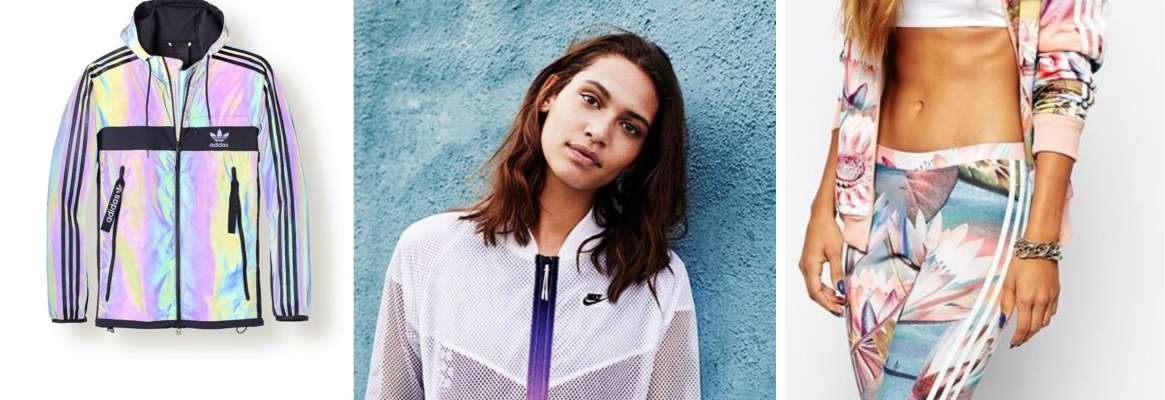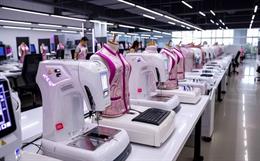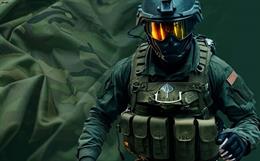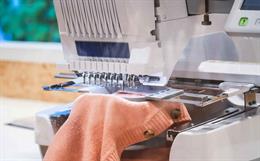As major sport brands are increasingly adding new functionsto products, sportswear for kids and the fast -growing China market are expected to draw much of their attention.
Two of the biggest brand stories over the past 12 monthshave been the impact of sportswear sales as a result of the 2006 FIFA World Cupheld in Germany, and the US$3.8 billion acquisition and integration of Reebokinto the Adidas Group.
These events have left Adidas buoyant, recently announcingthat it expects its net income in 2006 to approach 500 million euros from salesof 10 billion euros. For the first nine months of 2006, Adidas sales were up52% and operating profit climbed 23%.
The group will further increase investment in Reebok in2007, having allocated extra cash for advertising, new media, point-of-salecommunication, product development and initiatives to grow the brand inemerging markets. "We have made significant progress in the Reebok integrationso that today it is in much better shape than it was at the time of theacquisition in January 2006," says Chairman and CEO Herbert Hainer."We intend to increase our investment in the brand in 2007. For the AdidasGroup, 2007 will again be a year of record sales and earnings."
The 2006 FIFA World Cup was without doubt a gravy train forthe German-headquartered group, which were the official sponsor, supplier andlicensee of the event.
"We exceeded all of our football and business goals forthe World Cup," said Mr Hainer.
In fact, a record three million replica Adidas footballshirts were sold prior to the event, which included 1.5 million German nationalteam shirts. By comparison, Adidas sold 1.5 million football shirts and 250,000German shirts at the last World Cup held in Japan and South Korea in 2002.
"One trend confirmed at this year's World Cup is thatthe fans are going to the games in the shirts of their team," added MrHainer.
In addition, over one million pairs of Adidas+Predator Absolutefootball boots and 750,000 +F50Tunit football boots were sold.
Even following the integration of Reebok, however, theAdidas Group still lags behind Nike, which achieved 2006 sales of US$14.9billion (11.3 billion euros) and profit of US$1.39 billion (just over 1 billioneuros).
Recently Nike's President Charlie Denson announced anaggressive growth strategy with the goal of achieving clear brand dominance infootball by 2010.
"In a little over a decade, we've built Nike footballfrom nothing to a $1.5 billion business that saw 20% growth last year," hesaid. "Now we're ready to separate from the pack and create competitivedistance. Everywhere in the world, we intend Nike to be the brand consumersthink of when they think football."
Nike also currently sponsors many football clubs and players,including two-time FIFA Player of the Year Ronaldinho, and in Novemberintroduced its signature line of Ronaldinho footwear and apparel- the first signaturecollection Nike has ever introduced for the sport.
New Technologies in Sportswear
As leaders in the field, both Nike and Adidas have also been active in trying to introduce new technologies into sportswear, most recently in integrating electronics into kit for performance mapping. "
Although design and aesthetics of our products appear to be the most important factor for consumer acceptance of our products, technical innovation in the design of footwear, apparel, and athletic equipment is also essential to commercial success," said a Nike spokesman. "Research and development plays a key role in technical innovation. We rely on specialists in the fields of biomechanics, exercise physiology, engineering, industrial design and related fields, as well as research committees and advisory boards made up of athletes, coaches, trainers, equipment managers, orthopedists, podiatrists and other experts to develop cutting edge performance products. While we strive to produce products that help to reduce injury, enhance athletic performance and maximize comfort, failure to introduce technical innovation could result in a decline in consumer demand for our products."
Nike + iPod
It was announced in September 2006 that in just 10 weeks since the retail launch of the Nike + iPod wireless system enabling footwear to transmit data on time, distance, calories burned and pace with iPod nanos, over one million miles had been logged by runners the equivalent to circling the world more than 40 times.
"Nikeplus.com is fast becoming the world's biggest online running community," claimed Trevor Edwards, Nike's Chief Marketing Officer. In October 2006, Nike+ also launched in more markets in Europe, including France, Spain, Italy, Germany and The Netherlands, as well as Japan and Australia.
Addidas 1
The Adidas 1 running shoe, introduced in 2005, meanwhile, was launched in an improved version in 2006., Adidas 1 is designed to adapt itself in real time to find the right cushioning level, whatever the wearer's weight, surface or pace and the latest 1 .1 version is said to make the shoe better, stronger and faster, which can increase range of cushioning, meaning the shoe can become even softer or firmer.
"Advances in electronics come very quickly," said Adidas innovation team leader Christian Di-Benedetto. "By using electronics in sporting goods, we are able to improve product capabilities quickly and keep moving forward. There is a lot of untapped potential in this field."
Project Fusion
Adidas also joined forces with electronics firm polar electro in 2006 to introduce Project Fusion, which combines polars heart rate and speed and distance monitoring equipment into Adidas apparel and footwear.
Special fibers bonded onto Adidas tops work in conjunction with Polars wear link technology to eliminate the need for a separate chest strap to monitor heart rate. The tiny Polar Wearlink connector is just snapped onto the front of the shirt and ready to go.
The data is sent to the polar Rs. 800 wrist-mounted running computer, which easily displays and records all information in real time.
The AdiStar Fusion shoe has a strategically-placed cavity in the midsole which can house the very light Polar s3 stride sensor, making it easier to use, more comfortable and more consistently accurate than top-of-shoe systems.
Information including speed and distance, chronograph functions, along with heart rate, are also shown on the RS800 in real time. And when the workout is over, all data can be downloaded onto a computer so workouts can be easily managed and analyzed.
ISPO Wearable Technology
In Europe, the ISPo Summer meeting, which took place in Munich from July 16-18 last year held its first Wearable Technology event, featuring products ranging from backpacks with solar cells and helmets with cameras to functional jackets with G PS navigation, T-shirts with iPod controls and gloves with integrated MP3 players. ISPo will be staging a second Wearable Technology event at its winter 2007 meeting, again in Munich on February 4-7.
Competing on Functionality
New developments in sportswear have always been about increasing functionality in order to allow the wearer to improve performance.
The Gore-Tex Comfort Mapping concept, for example, which is being adopted in collections by the top names in sports and performance wear, arose from a study of ways to minimize the loss of warmth in highly functional garments for mountaineers.
Experiments showed that the cooling effect on the shoulders could be considerably reduced by using an optimized construction consisting of several laminates without a significant loss of breathability. Characteristics such as warmth, high breathability or stretch can be put into precisely those parts the Nike Sphere React fabric range. of the jacket where they are needed.
In the field of outdoor and alpine garments, this calls for Gore-Tex XCR laminates in the greater portion of the jacket, where they guarantee optimal freedom of movement and extreme breathability. Fleece-lined Gore-Tex soft shell laminates are then used to prevent chilling in problem zones such as the shoulders and kidneys. Elsewhere, PacLite fabric is used for breathability and its light weight, and Airvantage for added insulation.
Active Protection System
Dow Corning's patented Active Protection System, meanwhile, consists of a three-dimensional spacer textile treated with a special silicone coating which remains soft and flexible under normal conditions but hardens instantly upon impact.
When the impact force is removed, the material immediately returns to a flexible state.
The combination of benefits this technology offers for high-performance apparel include:
- Fully integrated
active safety that can be stitched directly into garments (unlike rigid
systems that often require the use of removable components)
- Material
customization and versatility that allow many creative de- sign possibilities.
- Breathable,
flexible and lightweight construction for comfort and freedom of movement.
- Washability for easy care and maintenance
Nike Sphere React Fabric Range
Japan's Teijin Fibers developed the "self-regulating fiber", which it is supplying exclusively to New stores with children's articles are plying exclusively to Nike for use in the nike sphere react fabric range.
Nike Sphere React Dry fabric activates in reaction to moisture, transforming from a flat fabric to a three-dimensional structure that reduces cling to the body. The material increases to nearly twice its original thickness in an engineered pattern. It can reduce stickiness by around 50%, compared with conventional polyester products, Teijin said.
Airflow across the skin increases to aid evaporative cooling and when the sweat has evaporated, post exercise, the lightweight micro fiber fabric returns to a flat shape against the body.
Teijln's MRT (Moisture Responded Transformable) fiber stretches when moisture is absorbed and shrinks when tt dries out, enabling the control of both moisture absorption and stretch. It is the subject of 16 patents in Japan and three elsewhere.
At the heart of the development is a new polyester ester polymer that absorbs and discharges moisture quickly. This is aligned with the production of a special textured yarn which controls the amount of water absorbed and discharged, the degree of stretch or shrinkage and the response speed.
The Nike project has also involved the development of special weaving, knitting, and dyeing and finishing technologies to develop a fabric structure that realizes the two different functions and changes both its shape and level of breathability in moist environments.
Nike and Teijin have also jointly developed optimal sewing requirements and product design for commercializing the Nike Sphere React fabric.
Sportswear for Kids are popular
Another key trend in Europe identified at the ISPO Summer 06 event was the growing market for children.
New stores with childrens articles are opening everywhere it was said and old stores are sprucing up their products ranges and restructuring them.
ISPO's Kids' Zone was the first separate platform for collections and products specifically for children.
From Nordic Walking, which supplies hiking and climbing gear to tennis rackets, surfboards and skateboards, brands are said to be increasingly switching from toned-down adult versions to functional and meaningful products developed specifically for smaller bodies.
An increasing number of separate collections will be available soon, which provide exactly what the adults get- highly functional, protective gear that looks good.
Manufacturers are producing better kids wear, which are very hardy, block out dirt, abrasion, moisture and cold and are more rip-proof than many adult products.
As a result, not only the same high quality materials will be used as for adults in the future, but also additional reinforcements, extra seams or details such as reflecting and illuminating strips, zip-off sleeves and pants' legs, easy-to-use Velcro closures, all the way to clips for cell phones and iPods with headphone outlets.
Shirts, caps and shorts are becoming increasingly functional with UV protection and new, light fabrics, which dry quickly and are light and cool. Feeling well is in with soft and light sweats and jersey materials, airy poplin, light canvas and denim, with cooling crinkle and seersucker. Underwear and socks are also getting climate regulating, highly elastic materials all the way to sweat panels and ergonomic cuts.
Fast Growing China Market
Nike spent US$20 million on advertising on China in 2005 in a bid to advance its position in the fastest-growing market in the world, in which it is said to have already established a 30% share.
Adidas, meanwhile, announced plans to open 40 shops a month to more than double its sales locations in China to 4,000 by 2008 - the year of the Beijing Olympics.
The statuesque and symbolic presence of Shanghai native Yao Ming - a super idol to millions of Chinese sports fans, and also the star of US basket- ball team Houston Rockets - is a further component in the challenge to Nike's crown by Adidas.
But with over 600 local brands, China's highly-fragmented sports apparel and footwear market will grow at an average 25-30% a year until 2008, according to analyst Macquarie Securities.
In the run-up to the Beijing Olympics, there appears to be more opportunity than ever for Asia's suppliers of fabrics to the Ieading sports brands, and at the same time for emerging local brands to challenge the supremacy of Adidas, Nike and the rest.
However, it is worth noting the trend for increased functionality in fabrics as a unique selling point in final products, whoever is branding them.
Meanwhile, after Germany and football, the sportswear world is further gearing itself towards China and children. Pakistan s exports in terms of quantity present a mixed picture, the general declinein their price in the international market has deprived Pakistan of US$ 563 million the survey said.
Listing various other issues regarding the declining exports, the survey sated that the elss than satisfactory export performance of textile manufacturers could be attributed to a variety of factors.
Firstly, it appears that Pakistans textile exporters were unable to compete with China, India and Bangladesh in the international market.
Secondly, the discriminating dumping duty of 5.8 % on the bed linen export has also affected pakistans competitiveness.
Thirdly, the poor quality of cotton on account of contaminated cotton issue has also adversely affected the exports of the spinning industry.
Fourthly, the rise in pima cotton price a genetically modified version which is imported from the USA and a critical input for producing higher quality bed wear and fabrics has made it difficult for Pakistani exporters to us it in their products.
Pakistans exports are based on a few items namely: cotton, leather, rice, synthetic textiles, and sports goods. These five categories of exports account for 77.2% of the total exports.
During the first nine months of 2006-07, the cotton manufacturers alone contributed 61.5%, followed by leather4.5%, rice 6.6% synthetic textiles 3%, and sports goods 1.6%. The degree of concentration has changed little form th last fiscal year.
Further breakup reveals that almost all export earnings have originated from textiles manufacturers.
Though Pakistan trades with a large number of countries, its exports are however highly concentrated in a few countries including the USA, Germany, Japan, the UK, Hong Kong, Dubai and Saudi Arabia, which account for one-half of its exports.
The United States is the single largest export market for Pakistan, accounting for 28.4 percent of its exports followed by the UK and Germany. Japan is fast diminishing as an export market for Pakistan as its share in total exports has been on the decline, reaching less than one percent from 5.7 percent a decade back.
Pakistan needs to diversify TTS exports not only in terms of commodities but also in terms of markets. "Heavy concentration of exports in few commodities and few markets can lead to export instability," the survey added.
Solar-Powered Clothing
Hohenstein Institutes will present two current research activities at the Avantex trade fair from June 10-12.
The research organization has gathered nine partners from industry and research since 2003 to look into options for integrating solar cells in clothing to supply the energy to power small mobile devices as part of the Solartex combined research project.
With the optimized plug connections and particularly flexible, mechanically stable solar cells, the resulting prototype is able to withstand treatment in domestic washing machines. A fundamental requirement necessary for serial production in industry has therefore been satisfied now.
Hohenstein Institutes will also be presenting a practical functional prototype developed in conjunction with the Institute of Physical Electronics at the University of Stuttgart (lPE). The men's outdoor jacket supplies the energy for electronic devices such as an MP3player using integrated solar cells.
To read more articles on Textile, Industry, Technical Textile, Dyes & Chemicals, Machinery, Fashion, Apparel, Technology, Retail, Leather, Footwear & Jewellery, Software and General please visit http://articles.fibre2fashion.com
To promote your company, product and services via promotional article, follow
this link: http://www.fibre2fashion.com/services/article-writing-service/content-promotion-services.asp





_Small.jpg)

